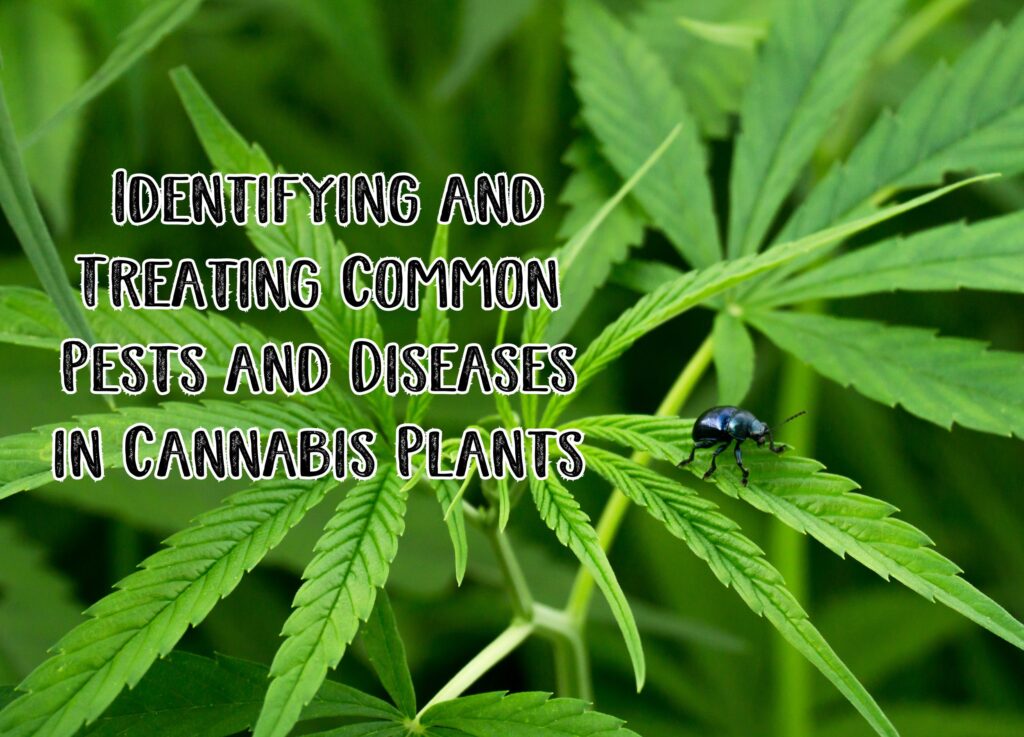Guard Your Garden: A Guide to Cannabis Plant Pests and Diseases
Growing cannabis can be a rewarding experience, but it’s not without its challenges. One of the most significant hurdles you’ll face is dealing with common pests and diseases that can wreak havoc on your plants. In this article, we’ll cover how to identify, treat, and prevent these issues to ensure a healthy harvest.
Identifying Common Pests
Pests can be a real nuisance in any garden, but they can be especially damaging to cannabis plants. Here are some of the most common pests you’ll encounter:
- Spider Mites: These tiny bugs suck the sap out of your plants, causing yellow spots and eventually killing the leaves.
- Aphids: These small insects also suck plant sap and can transmit diseases.
- Whiteflies: Similar to aphids, they suck plant juices and can lead to mold due to the honeydew they produce.

Treating Pests
Once you’ve identified the pests, the next step is treatment. Neem Oil is a popular organic option that acts as both an insecticide and fungicide. It’s available on Amazon and can be applied directly to the leaves of your plants.
For a non-chemical option, Yellow Sticky Traps can be placed around your garden to catch flying insects like whiteflies and aphids.
Identifying Common Diseases
Diseases can be just as damaging as pests, if not more so. Here are some common diseases to watch out for:
- Powdery Mildew: Appears as white powdery spots on leaves and stems.
- Root Rot: Causes the roots to become mushy and brown.
- Cannabis Mosaic Virus: Leads to twisted leaves and discolored patches.
Treating Diseases
Treatment for diseases will depend on the specific ailment. For fungal issues like powdery mildew, a Disease Control Fungicide Spray can be effective. This is also available on Amazon and can be applied directly to the affected areas.
Preventative Measures
Prevention is always better than cure. Here are some tips to help prevent pests and diseases:
- Regular Inspection: Check your plants regularly for signs of pests or diseases.
- Proper Spacing: Make sure your plants are not too close together to allow for good air circulation.
- Cleanliness: Keep your grow area clean to prevent the spread of diseases.
Dealing with pests and diseases is an unfortunate part of growing cannabis, but it’s not insurmountable. With the right knowledge and tools, you can identify, treat, and prevent these issues to ensure a healthy and bountiful harvest.
If you’re looking to arm yourself against these common problems, consider picking up some Neem Oil and Yellow Sticky Traps from Amazon. These can be invaluable tools in your fight against pests and diseases.
By staying vigilant and taking prompt action at the first sign of trouble, you can keep your cannabis plants healthy and thriving. Happy growing!
Organic vs. Chemical Treatments
When it comes to treating pests and diseases, you have the option of going organic or using chemical treatments. Organic options like Neem Oil are generally safer for both the plants and the environment. They also won’t leave harmful residues on your cannabis buds. Chemical treatments can be more potent and act faster but use them cautiously and follow all safety guidelines.
Quarantine New Plants
If you’re introducing new plants into your grow area, it’s a good idea to quarantine them for a week or two. This will help ensure that they are not carrying any pests or diseases that could infect your other plants.
Soil and Water Quality
Believe it or not, the quality of your soil and water can also play a role in your plant’s susceptibility to pests and diseases. Poor quality soil can stress your plants, making them more susceptible to diseases. Similarly, water that is too hard or too soft can also cause issues. Always test your water and soil regularly to ensure they meet the needs of your cannabis plants.
Climate Control
Temperature and humidity levels can significantly impact the health of your cannabis plants. Too much humidity can lead to mold and mildew, while too little can stress your plants, making them more susceptible to pests. Invest in a good quality hygrometer to keep track of humidity levels and adjust as needed.
The Role of Beneficial Insects
Not all insects are bad for your cannabis plants. Insects like ladybugs and predatory mites can actually help control pest populations. If you’re growing outdoors, these beneficial insects might naturally find their way to your garden. For indoor grows, you can purchase them online and introduce them to your grow area.
Record-Keeping
Keeping records can help you identify patterns and catch issues before they become significant problems. Make a note of when you water your plants, when you apply nutrients, and any signs of pests or diseases. This information can be invaluable for diagnosing issues and planning future grows.
Growing cannabis is not without its challenges, but understanding how to identify and treat common pests and diseases can go a long way in ensuring a healthy harvest. From regular inspections to choosing the right treatment options, each step you take contributes to the overall well-being of your cannabis plants.
For those looking to be well-prepared, consider adding a Disease Control Fungicide Spray to your toolkit. It’s a versatile product that can tackle various diseases and is readily available on Amazon.
By taking a proactive approach and arming yourself with the right knowledge and tools, you can grow cannabis plants that are not only healthy but also high-yielding. So don’t let the bugs bite, and may your buds be ever bountiful. Happy growing!
As an Amazon Associate we earn from qualifying purchases through some links in our articles.




